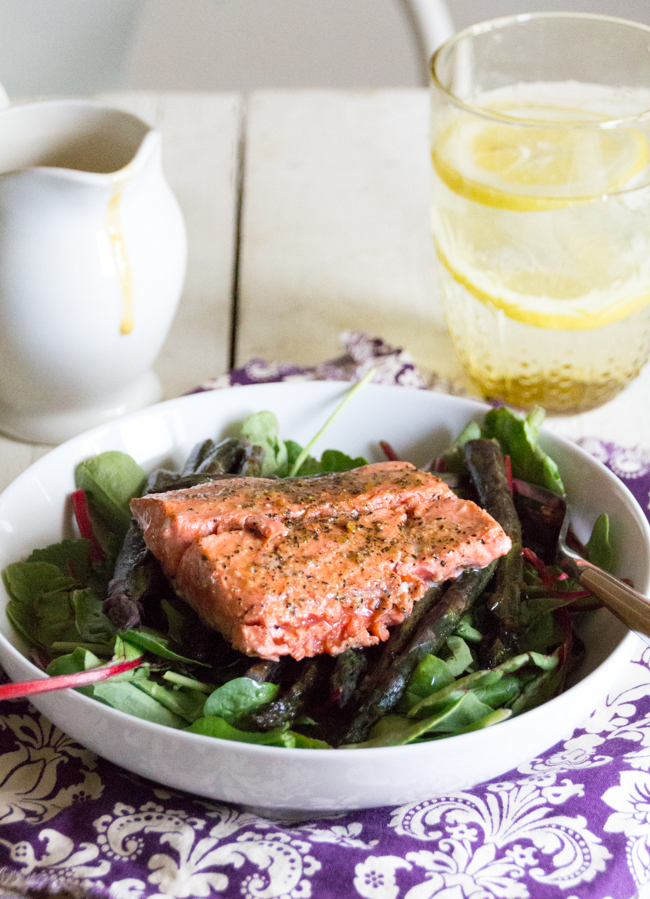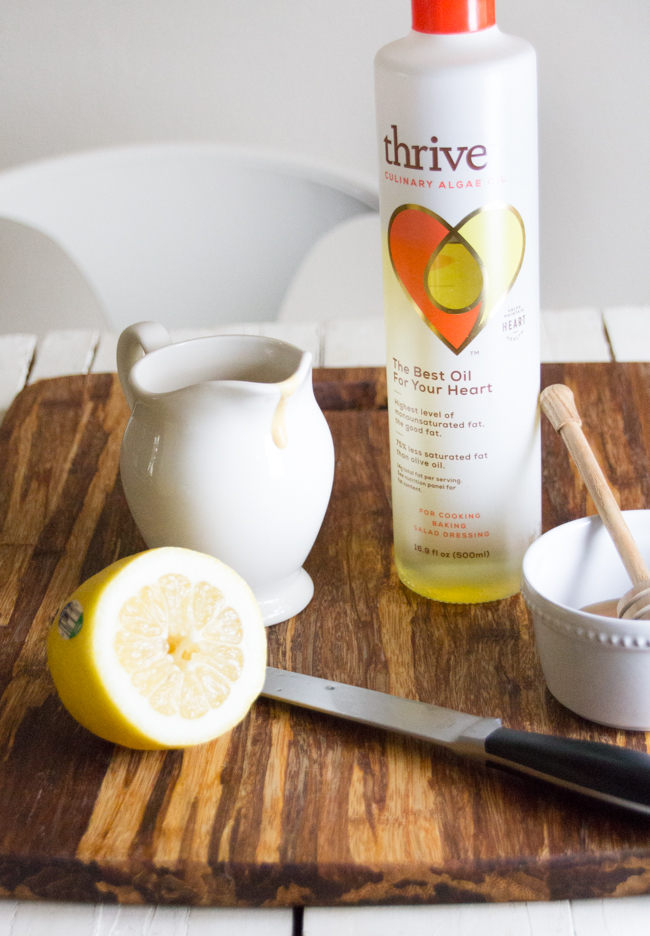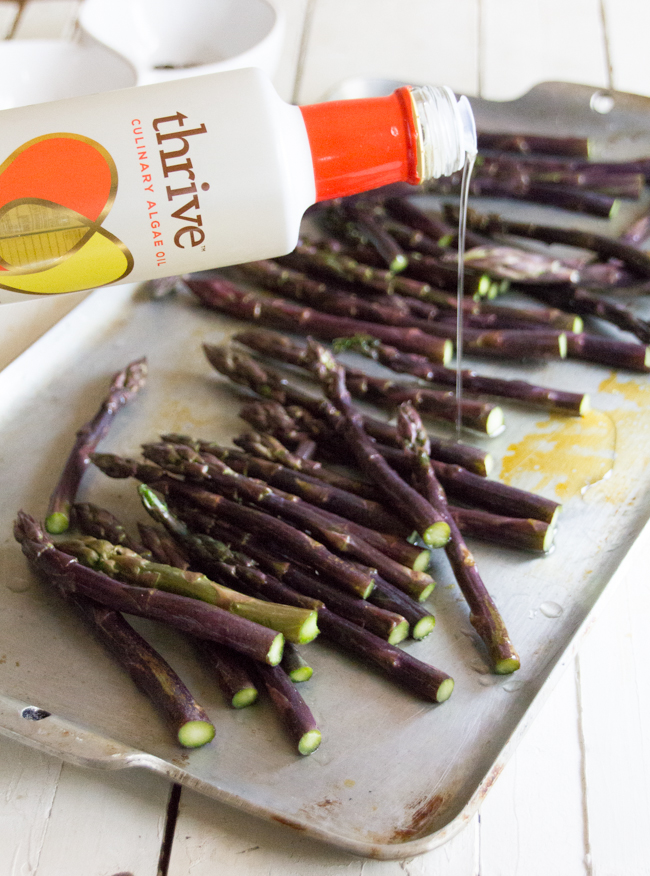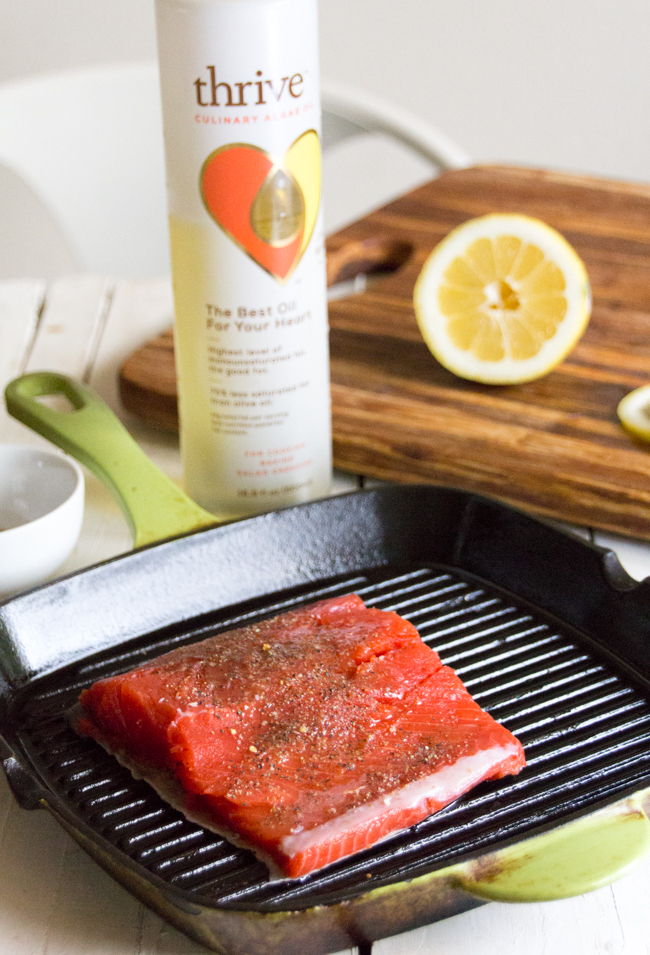This post contains affiliate links. Click here to read my affiliate policy.
Last Updated on December 6, 2020

When you hear the word ‘algae,’ I’m sure you immediately think swamps, ponds, and lakes, not cooking. Most people do, however, this new oil is slowly making its way into more kitchens, and people are loving it, even more than coconut oil (gasp!).
It’s important to ditch unhealthy, highly processed oils, like canola, soybean, corn, sunflower, safflower, etc. and replace them with healthier oils such as olive, coconut and now Thrive® Culinary Algae Oil. Vegetable oils must go through a chemicalized process in factories because they cannot naturally separate or be pressed. Usually, the crops are genetically modified and heavily sprayed with pesticides. Then, they are extracted, deodorized and altered. They are some of the most processed foods in our diets.

Vegetable oils are anything but healthy, but many times they are marketed as “healthy,” so be careful when you’re shopping because they are found in many processed foods, from condiments and dressings to nuts and seeds. These cheap oils are usually hydrogenated, which turns them into trans fats. Trans fats are extremely unhealthy and have been linked to heart disease and cancer. There are also large amounts of omega-6 fatty acids in these oils that can result in oxidation and inflammation in the body.
Therefore, it’s best to stay away from these vegetable and seed oils and trans fats. Thrive® Culinary Algae Oil is the perfect healthy alternative and tastes delicious as well.
What is Algae Oil?
Algae is considered one of the earth’s superfoods and naturally produces oil. One of the first major makers who is pioneering the consumption of this new oil is Thrive® Culinary Algae Oil. Their goal is to have “the most sustainably produced cooking oil” this year, “with more Thrive® Algae Oil produced per acre of land, and a lower carbon and water footprint, than nearly all cooking oils.”
In their mission, they claim: “We are advancing nutrition through algae oil, poised to be one of the planet’s most sustainably made food sources, to help people live better lives. The average person gets only half the daily monounsaturated fat (MUFA) that they need, and about 50% more saturated fat (the fat you want to stay away from) than is recommended. Thrive Algae Oil helps to restore the balance.”
So how is it made? They use the process of fermentation to produce the oil. They place the algae in large fermenter tanks for a few days, just like makers of wine and beer, and allow the algae to consume renewable plant sugars to make the oil. Then, they use an expeller to press the algae to release the oil, which is the same pressing method used for coconut and seed oils. Finally, the leftover algae are used for renewable energy and many other uses, leaving no waste.

Benefits of Algae Oil
Algae oil is slowly rising to stardom in the health and wellness and culinary worlds because it has many perks and health benefits.
It has a high smoke point (485 degrees) so it’s very easy to cook with, including frying, sauteing, searing, stir-frying, and baking. You can even make sauces, dressings, and marinades with it. Compared to other flavorful oils, the taste is very light and neutral, so don’t worry about any fishy taste. Its lightness allows the natural flavors of your food to come through and shine. Yes, it is Bejelly picky eater approved and is now one of my favorite oils to use when making homemade mayo.
Aside from its versatility in the kitchen, algae oil has the highest level of monounsaturated fat (the good fat). In fact, just one tablespoon gives you 13 g of monounsaturated fat, which is like eating an entire avocado. And if you’re worried about saturated fats, don’t be. This oil only contains 0.5 g of saturated fat per serving. That’s 75% less saturated fat than olive oil.
Here are some other health benefits associated with algae oil:
- Helps maintain heart health
- Helps maintain healthy blood pressure
- Helps maintain healthy blood sugar levels
- Reduces inflammation
- Boosts eye health
- Supports healthy pregnancy
- Improves memory
- Aids in cognitive development and function
If you haven’t tried using this latest oil in your cooking yet, here is a recipe to get you started.
If you love this Creamy ginger dressing with grilled salmon, you’ll like:
Seared Scallops and Cauliflower Rice Risotto
Ginger Chicken (Whole30, Keto)

Creamy ginger dressing with grilled salmon and roasted asparagus
Grilled salmon topped with a ginger sauce
Ingredients
Creamy Ginger Dressing
- 2 egg yolks
- 1 tablespoon lemon juice
- 1 tablespoon apple cider vinegar
- 1/2 teaspoon sea salt
- 1 cup Thrive Culinary Algae Oil
- 1 tablespoon minced ginger
- 1 tablespoon tamari
- 1 tablespoon honey
- 1 tablespoon Apple Cider Vinegar
Oven Roasted Asparagus
- 2 tablespoons Thrive Culinary Algae Oil
- 1/2 teaspoon sea salt
- 1/2 teaspoon black pepper
- 1 lb asparagus
Grilled Salmon
- 2 Tablespoons Thrive Culinary Algae Oil
- 1/2 teaspoon sea salt
- 1/2 teaspoon lemon pepper
- 1/2 teaspoon coconut sugar, or sugar of choice
- 1 lb fresh salmon
Instructions
- To make the dressing, add the egg yolks, 1 tablespoon of apple cider vinegar, lemon juice and sea salt to a blender.
- Turn the blender on low and slowly drizzle in the Thrive Culinary Algae Oil. Pulse on low until it emulsifys .
- Then add in the rest of the dressing ingredients and pulse on low until combined. Pour into a glass container and store in the fridge until ready to eat.
- To make the Roasted asparagus, preheat your oven to 400 degrees.
- On you baking sheet place the asparaus and drizzle the Thrive Culinary Algae Oil over it. Sprinkle with salt and pepper and toss the asparagus with your hands until coated.
- Place the baking sheet in the oven and bake for 10 minutes. Remove from the oven and set aside until cooled
- To make the grilled salmon, place the sea salt, lemon pepper and sugar in a small bowl and mix with a spoon until combined.
- Place your grill pan on your stove over medium high heat.
- Coat both sides of the salmon with the Thrive Culinary Algae Oil and then sprinkle the seasoned salt on both sides.
- Place the salmon on the grill and cook for 2 to 3 minutes until dark pink and flip and repeat.
- Remove the salmon from the oven and set on a plate.
- In two bowls place some salad mix and the top with the grilled asparagus, salmon and then place the dressing on top. Enjoy!

This post is sponsored by Thrive® Culinary Algae Oil. I only share with you my honest opinions and brands that I love.

